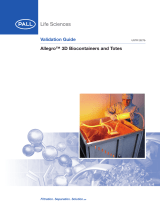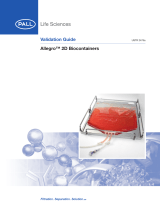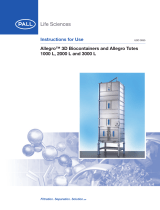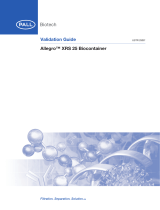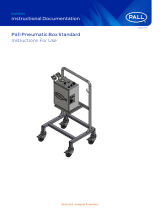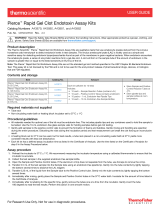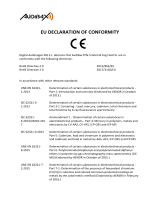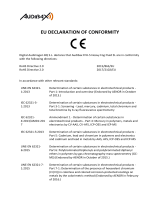Page is loading ...

USTR 3008
Validation Guide
Allegro™ TK8 Film

2
Contents
A. General description of the Allegro TK8 film...............................................................................................5
B. Properties of the Allegro TK8 film ..............................................................................................................6
B1. Mechanical testing ..................................................................................................................................6
B1.1. Gelbo ............................................................................................................................................6
B1.2. Strength and elongation ................................................................................................................6
B1.3. Puncture resistance........................................................................................................................6
B1.4. Dart impact ....................................................................................................................................6
B1.5. Tear resistance ..............................................................................................................................6
B2. Physical testing ......................................................................................................................................6
B2.1. O2transmission rate ......................................................................................................................6
B2.2. CO2transmission rate ....................................................................................................................6
B2.3. Water vapor transmission rate ........................................................................................................6
B3. Chemical and biological testing ..............................................................................................................7
B3.1. Bacterial endotoxin USP <85> ......................................................................................................7
B3.2. Biological reactivity – in vitro – ISO 10993-5 and USP <87> ..........................................................7
B3.3. Biological reactivity – in vivo – ISO 10993-11, ISO 10993-10, ISO 10993-6 and ----USP <88> ....7
B4. Physicochemical tests ............................................................................................................................7
B4.1. Tests on plastic materials and components used to package medical articles USP <661> ............7
B4.2. Tests on plastic containers for aqueous solutions for parenteral infusion EP 3.2.2.1 ......................7
B5. Functional testing ....................................................................................................................................8
B5.1. Accelerated ageing ........................................................................................................................8
B5.2. Sterilization validation ....................................................................................................................8
B5.3. Freezing study................................................................................................................................8
B6. Overview testing results ..........................................................................................................................8
B6.1. Mechanical results..........................................................................................................................8
B6.1.1. Gelbo ................................................................................................................................8
B6.1.2. Strength and elongation ....................................................................................................9
B6.1.3. Puncture resistance ..........................................................................................................9
B6.1.4. Dart impact ........................................................................................................................9
B6.1.5. Tear resistance ..................................................................................................................9
B6.2. Physical testing ............................................................................................................................10
B6.2.1. O2transmission rate ........................................................................................................10
B6.2.2. CO2transmission rate ....................................................................................................10
B6.2.3. Water vapor transmission rate ........................................................................................10
B6.3. Chemical and biological testing ....................................................................................................10
B6.3.1. Bacterial endotoxin USP <85> ........................................................................................10
B6.3.2. Biological reactivity – in vitro – ISO 10993-5 and USP <87> ..........................................10
B6.3.3. Biological reactivity – in vivo – ISO 10993-11, ISO 10993-10, ISO 10993-6 and <88> ....10

B6.4. Physicochemical test results ........................................................................................................11
B6.4.1. Tests on plastic materials and components used to package
medical articles USP <661> ............................................................................................11
B6.4.2. Tests on plastic containers for aqueous solutions for parenteral infusion EP 3.2.2.1 ........11
B6.4.3. Tests on polyethylene with additives for containers for parenteral preparations and for
ophthalmic preparations EP 3.1.5 ....................................................................................11
B6.5. Functional testing ........................................................................................................................11
B6.5.1. Accelerated ageing ..........................................................................................................11
B6.5.1.1 Accelerated ageing tests on film properties........................................................11
B6.5.1.2 Accelerated ageing tests on weld properties......................................................13
B6.5.2. Sterilization validation ......................................................................................................14
B6.5.3. Freezing study..................................................................................................................14
C. Extractables and leachables data of the Allegro TK8 film......................................................................16
C1. Extractables study ................................................................................................................................17
C1.1. Introduction ................................................................................................................................17
C1.2. Study purpose ............................................................................................................................17
C1.3. Results of extractables study ......................................................................................................18
C2. Leachables studies................................................................................................................................19
C2.1. Introduction ................................................................................................................................19
C2.2. Study purpose ............................................................................................................................20
C2.3. Test methods ..............................................................................................................................20
C2.3.1. pH ..................................................................................................................................20
C2.3.2. Conductivity ....................................................................................................................20
C2.3.3. TOC ................................................................................................................................20
C2.3.4. Metals..............................................................................................................................21
C2.3.5. Volatile organic compounds via purge- and trap GC/MS ................................................21
C2.3.6. Semi-volatile organic compounds via dichloromethane extraction + GC/MS....................21
C2.3.7. Non-volatile organic compounds via dichloromethane extraction + LC/MS......................22
C2.4. Evolution of pH with time ............................................................................................................22
C2.5. Evolution of conductivity with time ..............................................................................................23
C2.6. Evolution of TOC with time ..........................................................................................................23
C2.7. Evolution of metals with time ......................................................................................................24
C2.8. Evolution of extracted components with time ..............................................................................24
C2.9. General conclusion of leachables studies ....................................................................................26
C2.10. Summary of results....................................................................................................................26
C2.11. Leachables study full results......................................................................................................33
C2.11.1. Test solution WFI ........................................................................................................33
C2.11.2. Test solution Ethanol 20% ..........................................................................................33
C2.11.3. Test solution HCl..........................................................................................................33
C2.11.4. Test solution NaOH......................................................................................................33
C2.11.5. Test solution NaCl........................................................................................................33
C2.11.6. Test solution DMSO 10% ............................................................................................33
C2.11.7. Test solution Tween 0.1% ............................................................................................33
www.pall.com/biopharm 3

4
D. Chemical Compatibility Test.....................................................................................................................33
D1. Study purpose ......................................................................................................................................33
D2. Test methods ........................................................................................................................................33
D3. Test solutions ........................................................................................................................................34
D4. Results of the chemical compatibility tests ............................................................................................34
E. Statement on TSE/BSE and animal derived components ......................................................................37

A. General description of the Allegro TK8 film
The Allegro TK8 film is constructed from laminated layers of PA (polyamide), EVOH (ethylene vinyl alcohol
polymer) and ULDPE (ultra low density polyethylene). The outer PA layer provides robust puncture
resistance, strength, and excellent thermal stability. The EVOH layer minimizes gas diffusion across
the film while maintaining a very good flex crack resistance. The ULDPE layers provide flexibility,
integrity and an ultra-clean, ultra-pure, low-extractables product contacting layer.
• PA layer
– Polyamide layer:
– Mainly used as heat resistant layer that provides additional strength, puncture resistance,
impact and tear resistance to the film.
• EVOH layer:
– Ethylene vinyl alcohol
– Minimizes gas diffusion
– Good flex crack resistance
• Tie layers:
– Are required to bond the various film layers.
• ULDPE layer:
– Ultra Low Density Polyethylene
– Contributes to a soft, transparent and extreme flexible film also resulting in a very low level
of extractables.
– Very good water vapor transmission rate.
www.pall.com/biopharm 5
PA
tie
tie
tie
25 µm
ULDPE 50 µm
EVOH Total thickness = 250 µm
For robust puncture
resistance, strength, excellent
thermal stability
For excellent ex
crack resistance, minimizes
gad transfusion
For excellent exibility,
low extractables
10 µm
ULDPE 100 µm
ULDPE 50 µm

6
B. Properties of the Allegro TK8 film
B1 . Mechanical Testing
Test type and general description Standard Summary description of standard
B1.1. Gelbo ex ASTM F392-93 This test covers the ex crack resistance
Determines the ex resistance of materials of materials by the formation of pinholes.
by the formation of pinholes Specimen (=sealed lm tube) are twisted
and horizontally folded at a constant rate
and at different test cycles: 500, 1000,
5000 or 10000 test cycles. The number
of pinholes is measured by lling the
tube with H2O.
B1.2. Strength and elongation ASTM D882-91 This test method covers the determination
A measure of the force required to stretch of tensile properties of plastics in the
a material to its breaking point form of thin sheeting, including lm, less
than 1.0 mm (0.04 in.) thick.
B1.3. Puncture resistance FTMS 101B A pressing bar with a xed diameter will
Puncture resistance testing predicts the durability be pushed through the lm at a constant
of the lm while in use. Films with high puncture speed. The pressure force, needed to
resistance correspond with material that can break the lm, will indicate the puncture
absorb the energy of an impact by both resistance resistance of the lm.
to deformation and increased elongation. Puncture
resistance, measured in energy units, evaluates
the lm strength and extensibility properties.
B1.4. Dart impact ASTM D1709-01B Described are two testing methods
Test method covers the determination of the depending on the size of the striker,
energy that causes plastic lm to fail under which are determined by the impact
specied conditions of impact of a free-falling dart. resistance of the material. The standard
technique is a staircase method to drop
a weight and increase or decrease
depending in pass or fail. Standard
apparatus and striker has been described.
B1.5. Tear resistance Test is designed to measure the force to
Determines the tear resistance of exible propagate tearing.
plastic lm.
B2. Physical Testing
Test type Standard Summary description of standard
B2.1. O2transmission rate ASTM F-1927 Determines the steady-state rate of
23 °C, 90% RH inside transmission of O2gas through material
50% RH outside at a given temperature and relative
humidity.
B2.2. CO2transmission rate ASTM F-2476 Determines the steady-state rate of
23 °C, 0% RH transmission of CO2gas through
material at a given temperature and
relative humidity.
B2.3. Water vapor transmission rate ASTM F-1249 Uses an infrared sensor to measure
23 °C, water vapor permeability at 23 °C with
100% RH inside, 0% RH on the outside and 100% RH on
0% RH outside the inside to simulate worst-case use
conditions for a uid storage container.

B3. Chemical and Biological Testing
Test type and general description Standard Summary description of standard
B3.1. Bacterial endotoxin USP <85> Limulus amebocyte lysate (LAL) testing
Evaluates the presence of bacterial endotoxins is used to detect or quantify bacterial
in or on a sample endotoxins that may be present in or on
the sample of the article.
B3.2. Biological reactivity – in vitro USP <87> Results are obtained by placing the test
Evaluates the response of mammalian cell ISO 10993-5 and control materials (extracts) in
cultures to extracts of polymeric materials. separate cell culture media under
standard conditions. Cells are observed
for visible signs of toxicity (such as
change in size or appearance of cellular
components or a disruption in their
conguration) in response to the test
and control materials.
B3.3. Biological reactivity – in vivo USP <88> USP Biological Reactivity Test – in vivo
Evaluates the response in animals to exposure ISO 10993-11 for Class VI Plastics, is a series of three
of polymeric materials. ISO 10993-10 tests: systemic toxicity, intracutaneous
ISO 10993-6 reactivity and implantation. The rst two
are designed to determine the systemic
and local, respectively, biological responses
of animals to plastics and other polymers
by the single dose injection of specic
extracts prepared from a sample. The
implantation test is designed to evaluate
the reaction of living tissue to the plastic
and other polymers by the implantation
of the sample itself into animal tissue.
B4. Physicochemical Tests
Test type and general description Standard Summary description of standard
B4.1. Tests on plastic materials and components USP <661> Material dependent: measures the
used to package medical articles properties of impurities extracted from
Evaluates the physical and chemical properties plastics when leached with extraction
of plastics and their extracts. medium over a specied period and
temperature. Includes the following:
heavy metals, buffer capacity, and
non-volatile residue.
B4.2. Tests on plastic containers for aqueous EP 3.2.2.1 UPW is placed in a container and then
solutions for parenteral infusion extracted. Appearance of solution, acidity
or alkalinity, absorbance, reducing sub-
stances and transparency are evaluated.
www.pall.com/biopharm 7

8
B5. Functional Testing
Test type and general description Standard Summary description of standard
B5.1. Accelerated ageing ASTM F1980-02 Provides information for developing
accelerated ageing protocols to rapidly
determine the effects, if any, due to the
passage of time and environmental
conditions on the packaging material.
These data can be used to dene or sup-
port shelf-life. They address the primary
package as a whole and do not address
the package/product interaction.
B5.2. Sterilization validation ISO 11137 Validates the minimum gamma
Sterilization of healthcare products irradiation dosage necessary to claim
sterility at 10-6 sterility assurance level
(SAL), based on the bioburden level of
the uid path of the nished products.
B5.3 Freezing study Test on the effect of freezing at -70 °C
on Allegro 2D TK8 biocontainers.
B6. Overview testing results
B6.1. Mechanical results
The following mechanical properties were investigated; flex crack resistance (gelbo test), tensile
strength and elongation, film modulus, puncture resistance, dart impact and tear resistance. The
tests were carried out before and after gamma irradiation. The utilized level of gamma irradiation
was 50 kGy.
B6.1.1. Gelbo
Before gamma Before gamma After gamma After gamma
TK8 lot 146051 TK8 lot 148048 TK8 lot 146051 TK8 lot 148048
Results after 500 cycles
Average # pinholes 0 not done 00
Results after 1000 cycles
Average # pinholes 0.3 010.7
Results after 5000 cycles
Average # pinholes 6.3 3.3 8.7 8.7
Results after 10000 cycles
Average # pinholes not done 7 not done not done
Commentary
The flex crack resistance (gelbo test) was evaluated at 3 out of 4 different test cycles
(500, 1000, 5000 and 10 000), depending on the number of cycles at which a zero
value was obtained.

B6.1.2. Strength and Elongation
Before gamma Before gamma After gamma After gamma
TK8 lot 146051 TK8 lot 148048 TK8 lot 146051 TK8 lot 148048
Tensile and elongation
Max strength (MPa) - MD 29 31 25 28
Max strength (MPa) - TD 23 34 25 32
Elongation at break (%) - MD 140 130 250 129
Elongation at break (%) - TD 50 100 160 102
Young Mod (MPa) - MD 590 530 590 620
Young Mod (MPa) - TD 590 490 500 540
Commentary
The reported strength, elongation and modulus data are averages of at least 5 meas-
urements in both film directions. “MD” is the machine direction of the film and “TD” is
the transverse machine direction.
B6.1.3. Puncture Resistance
Before gamma Before gamma After gamma After gamma
TK8 lot 146051 TK8 lot 148048 TK8 lot 146051 TK8 lot 148048
Puncture resistance
Max load (N) 130 136 130 130
Deection at max load (mm) 9 10 99
Commentary
The puncture resistance of the films is expressed in Max load and Deflection at Max
load. Both reported values are averages of at least 10 measurements.
B6.1.4. Dart Impact
Before gamma Before gamma After gamma After gamma
TK8 lot 146051 TK8 lot 148048 TK8 lot 146051 TK8 lot 148048
Dart impact (g) 1260 >1300 1100 1150
B6.1.5. Tear Resistance
Before gamma Before gamma After gamma After gamma
TK8 lot 146051 TK8 lot 148048 TK8 lot 146051 TK8 lot 148048
Tear resistance
Avg force (N) - MD 31 33 17 21
Avg force (N) - TD 45 33 32 29
Initial max load (N) - MD 33 35 18 23
Initial max load (N) - TD 52 38 32 35
Commentary
The tear resistance is expressed in average force and initial max load to tear the film.
The measurement is carried out in machine direction (MD) and transverse machine
direction (TD).
www.pall.com/biopharm 9

10
B6.2. Physical testing
B6.2.1. O2Transmission Rate
Before gamma After gamma
Item Norm TK8 lot 146051 TK8 lot 146051
O2transmission rate ASTM D3985 (23 °C, 90% RH inside, 0.37 cc/m².day 0.52 cc/m².day
50% RH outside)
B6.2.2. CO2Transmission Rate
Before gamma After gamma
Item Norm TK8 lot 146051 TK8 lot 146051
CO2transmission rate ASTM F-2476 (23 °C, 0% RV) < 1 cc/m².day < 1 cc/m².day
B6.2.3. Water Vapor Transmission Rate
Before gamma After gamma
Item Norm TK8 lot 146051 TK8 lot 146051
Water vapor ASTM F1249 (23 °C, 100% RH inside, 0.41 g/m².day 0.40 g/m².day
transmission rate 0% RH outside)
B6.3. Chemical and Biological Testing
B6.3.1. Bacterial endotoxin USP <85>
Item Norm TK8 lot 148048
Bacterial endotoxin USP <85> < 0.005 EU/mL
B6.3.2. Biological reactivity – in vitro – ISO 10993-5 and USP <87>
Item Norm TK8 lot 148048 after gamma
Biological reactivity USP <87> PASS
in vitro ISO 10993-5 PASS
B6.3.3. Biological reactivity – in vivo - ISO 10993-11, ISO 10993-10, ISO 10993-6 and
USP <88>
Item Norm TK8 lot 148048 after gamma
Biological reactivity USP <88> PASS
in vivo ISO 10993-11 PASS
ISO 10993-10 PASS
ISO 10993-6 PASS

B6.4. Physicochemical Test Results
B6.4.1. Tests on plastic materials and components used to package medical articles
USP <661>
Item Norm TK8 lot 148048 after gamma
Test on plastic materials USP <661> PASS
and components used to
package medical articles
B6.4.2. Tests on plastic containers for aqueous solutions for parenteral infusion
EP 3.2.2.1
Item Norm TK8 lot 148048 after gamma
Test on plastic containers EP 3.2.2.1 PASS
for aqueous solutions for
parenteral infusion
B6.4.3. Tests on polyethylene with additives for containers for parenteral preparations
and for ophthalmic preparations EP 3.1.5
The European Pharmacopoeia chapter 3.1.5 refers to “Polyethylene with additives for
containers for parenteral preparations and for ophthalmic preparations”. Since the
Allegro TK8 film is a laminate containing different non PE resin types, this test is not
applicable for this film. We were therefore advised by the test lab not to perform this
test on the entire film.
However, the BR4 contact layer of the Allegro TK8 film is a polyethylene film. This film
was tested for compliance with EP 3.1.5 section “tests”. All tests passed except for
the “substances soluble in hexane”. The reason why it did not pass this test was the
low cristallinity of the resin. We repeated this particular test (substances soluble in
hexane) on the entire Allegro TK8 film. This test passed the evaluation criteria.
B6.5. Functional testing
B6.5.1 Accelerated ageing tests
The purpose of the accelerated ageing study is to prove a shelf life of 5 years on
Allegro TK8 film and biocontainers for film properties and weld properties. To mimic
normal use conditions, the first 3 years (will be non-gamma irradiated), the last 2
years (finished good shelf life) will be worst case gamma irradiated (min 50 kGy).
The accelerated ageing time was calculated on the basis of the Arrhenius reaction
rate function.
Accelerated ageing time = Real life time/AAF
AAF= Accelerated ageing factor= 11.3 following ASTM F1980-02 (if stored at 55 °C
and ambient temperature = 20 °C).
This means that 1 year at 20 °C is equivalent to 32.3 days at 55 °C.
B6.5.1.1 Accelerated ageing tests on film properties
For film properties the following batches are tested:
187062
193149
After 3 years of accelerated ageing the film was gamma irradiated (min
50 kGy) and aged for 2 years till a total of 5 years.
Results are listed in tables on the following pages.
www.pall.com/biopharm 11

12
Results lot 187062 for mechanical tests on film
Properties Spec t01 yr 2 yrs 3 yrs 3 yrs γ4 yrs γ5 yrs γConclusion
Tensile strength and elongation
Tensile strength at break MD Min 19 MPa 35 35 34 34 35 35 32 Conform
Tensile strength at break TD Min 19 MPa 34 35 35 36 35 37 37 Conform
Elongation at break MD Min 65% 145 237 208 154 144 126 124 Conform
Elongation at break TD Min 20% 109 195 160 126 114 107 117 Conform
Young modulus MD Min 330 MPa 844 752 556 549 647 697 559 Conform
Young modulus TD Min 330 MPa 1020 734 572 475 574 643 638 Conform
Puncture resistance
Max load Min 115 MPa 128 131 128 132 129 123 130 Conform
Deection at max load Min 7 mm 10 10 9 10 10 88Conform
Dart impact 700 g 987 900 923 907 962 1002 857 Conform
Flex crack resistance
500 cycles <2 pinholes 0.3 00 0 0 0 0 Conform
1000 cycles <4 pinholes 000.3 0.3 000Conform
5000 cycles <15 pinholes 10.7 56 12.3 977.3 Conform
Tear resistance
Average force MD Min 3 N 22 17 18 20 16 18 15 Conform
Average force TD Min 12 N 28 30 30 31 29 27 30 Conform
Initial max force MD Min 3 N 21 17 18 19 16 18 15 Conform
Initial max force TD Min 12 N 30 29 32 32 29 28 31 Conform
Results lot 193149 for mechanical tests on film
Properties Spec t01 yr 2 yrs 3 yrs 3 yrs γ4 yrs γ5 yrs γConclusion
Tensile strength and elongation
Tensile strength at break MD Min 19 MPa 34 34 34 36 33 36 32 Conform
Tensile strength at break TD Min 19 MPa 37 37 35 35 36 38 39 Conform
Elongation at break MD Min 65% 198 138 139 140 115 136 103 Conform
Elongation at break TD Min 20% 177 105 108 103 104 120 99 Conform
Young modulus MD Min 330 MPa 540 931 463 499 567 681 678 Conform
Young modulus TD Min 330 MPA 463 932 464 493 596 624 630 Conform
Puncture resistance
Max load Min 115 MPa 134 123 133 129 126 131 127 Conform
Deection at max load Min 7 mm 10 99 9 9 8 8 Conform
Dart impact 700 g 973 908 1007 1032 992 1002 995 Conform
Flex crack resistance
500 cycles <2 pinholes 0.3 00 0 0.3 00Conform
1000 cycles <4 pinholes 0.3 0.3 0.3 0 0.3 0.3 0.3 Conform
5000 cycles <15 pinholes 3 8.3 6.7 6 6.3 7.3 5 Conform
Tear resistance
Average force MD Min 3 N 27 25 25 24 13 14 13 Conform
Average force TD Min 12 N 37 44 39 38 31 22 18 Conform
Initial max force MD Min 3 N 30 29 26 28 14 17 15 Conform
Initial max force TD Min 12 N 43 47 44 38 33 26 23 Conform

Results for gas transmission properties of both lots at the end of the shelf life compared to initial values.
lot 146051** Lot 187062 Lot 193145
Item Norm T050 kGy g End of shelf life End of shelf life
O2transmission rate ASTM D3985 (23 °C, 90% 0.52 cc/m².day 0.31 cc/m².day 0.40 cc/m².day
RH inside, 50% RH outside)
CO2transmission rate ASTM F-2476 <1 cc/m2.day 0.95* cc/m².day 1.20* cc/m².day
(23 °C, 0% RH)
WVTR ASTM F-1249 (23 °C, 0.40 g/m².day 0.43 g/m².day 0.42 g/m².day
100% RH inside, 0%
RH outside)
*The lower detection limit of this test is 1 cc/m2.day. The measured values uctuate because the CO2TR is in the region of the lowest limit.
The given value is the average of 20 sequential measurements.
**This lot is used for the initial Allegro TK8 lm validation. The values given here are for new lm that was worst case gamma irradiated.
B6.5.1.2 Accelerated ageing tests on weld properties
The following batches of Allegro TK8 bodies are selected for the study.
Lot 3639089: Body, TK8, N-biocontainer, 25 L
Lot 3628676: Body, TK8, LM-biocontainer, 50 L
The Allegro TK8 bodies are aged accelerated in an incubator at 55 °C.
After an equivalent of 3 years for the film, the following batches of Allegro
TK8 biocontainers are made from the selected bodies:
Lot 3729587: 25 L biocontainers started from body lot 3639089
Lot 3729588: 50 L biocontainers started from body lot 3628676
These biocontainers are sent for gamma irradiation at 50 kGy (worst case
condition) and afterwards stored again in the incubator at 55 °C for 2
more years.
The biocontainers made for this study are engineered with several liquid
and powder fitments welded.
Results after biocontainer production lot 3729587
At each time point, 2 biocontainers are tested
3 years 3 years 4 years 5 years
Analysis Spec non gamma gamma gamma gamma Conclusion
Integrity test Pass Pass Pass Pass Pass Conform
Seal strength body(1) Min 45 N/15 mm Min 90 Min 79 Min 90 Min 97 Conform
Av 111 Av 103.78 Av 100.48 Av 105.19
Seal strength 90° weld(2) Min 45 N/15 mm Min 72 Min 74 Min 81 Min 87 Conform
Av 94.77 Av 96.52 Av 97.02 Av 99.92
Seal strength closure Min 45 N/15 mm Min 78 Min 98 Min 92 Min 101 Conform
weld(3) Av 100.67 Av 104.47 Av 98.61 Av 101.61
CpK all TK8-TK8 welds ? 1.25 1.62 3.54 4.30 ?
Seal strength liquid Min 25 N/15 mm Min 91 Min 83 Min 64 Min 54 Conform
tments(4) Av 109.27 Av 109.36 Av 94.81 Av 98.61
CpK 1.79 CpK 2.71 CpK 1.68 CpK 1.53
Seal strength powder Min 40 N/15 mm Min 79 Min 90 Min 85 Min 84 Conform
tments(5) Av 103.17 Av 104.35 Av 101.14 Av 102.95
CpK 1.68 CpK 2.42 CpK 2.65 CpK 2.45
Min: minimum measurement; Av: average
(1) Per biocontainer, each body weld is tested at 4 positions
(2) Per biocontainer the 2 90° welds are tested at 12 positions
(3) Per biocontainer, the 2 closure welds are tested at 2 positions
(4) Per biocontainer, 3 tments are tested at 2 positions
(5) Per biocontainer, 3 tments are tested at 3 positions
www.pall.com/biopharm 13

14
Results after biocontainer production lot 3729587
At each time point, 2 biocontainers are tested
3 years 3 years 4 years 5 years
Analysis Spec non gamma gamma gamma gamma Conclusion
Integrity test Pass Pass Pass Pass Pass Conform
Seal strength body(1) Min 45 N/15 mm Min 89 Min 89 Min 89 Min 100 Conform
Av 120.99 Av 114.21 Av 103.58 Av 108.68
Seal strength 90° weld(2) Min 45 N/15 mm Min 73 Min 86 Min 77 Min 83 Conform
Av 100.91 Av 106.28 Av 98.88 Av 102.89
Seal strength closure Min 45 N/15 mm Min 90 Min 103 Min 88 Min 92 Conform
weld(3) Av 107.37 Av 106.83 Av 93.80 Av 97.39
Seal strength liquid Min 25 N/15 mm Min 66 Min 89 Min 90 Min 81 Conform
tments(4) Av 104.81 Av 109.12 Av 106.16 Av 104.35
CpK 1.37 CpK 2.90 CpK 3.44 CpK 2.16
Seal strength powder Min 40 N/15 mm Min 87 Min 89 Min 88 Min 83 Conform
tments(5) Av 113.33 Av 103.07 Av 104.64 Av 103.40
CpK 1.51 CpK 2.42 CpK 2.86 CpK 1.92
Min: minimum measurement; Av: average
(1) Per biocontainer, each bodyweld is tested at 4 positions
(2) Per biocontainer the 2 90° welds are tested at 12 positions
(3) Per biocontainer, the 2 closure welds are tested at 2 positions
(4) Per bioconttainer, 3 tments are tested at 2 positions
(5) Per biocontainer, 3 tments are tested at 3 positions
B6.5.2 Sterilization validation
Our mixing and storage biocontainers are sterile after being irradiated at minimum
25 kGy.
Pall Life Sciences has validated the product according to the Vdmax25 method
(ISO11137).
A validation study was performed on our worst case Allegro TK8 product.
The validation study exits out of the following topics;
• Determination of the bioburden with a validated bioburden method according
to ISO11737-1.
• Acceptance of the dose verification experiment.
• Acceptance of the sterility tests with a validated sterility test method according
to ISO11737-2.
• Acceptance of sterility assurance level of 10-6 with a minimum irradiation dose
of 25 kGy.
• A triple dose mapping study confirming that a minimum of 25 kGy was reached and
not exceeding a maximum of 50 kGy.
• Quarterly execution of the dose audits.
B6.5.3 Freezing study
Preliminary studies have been performed on Allegro 2D biocontainers made of TK8
film to withstand freezing up to -70 °C.
Tests have been done to proof that 2D biocontainers withstand low storage
temperatures. Fifteen 2D biocontainers designed with Allegro TK8 film were stored
at −70 °C during 2 weeks. After which a series of tests have been performed.
Biocontainers have been tested with:

• C-flex tubing
• Platinum Cured Silicon tubing
The following tests have been performed:
• Visual control
• Integrity by pressure decay
• Drop test (Bayer method and ASTM D5487)
• Mechanical properties:
– Dimensions
– Frozen tubing robustness
– Frozen film folding
Test results:
• Visual control:
After freezing: The biocontainers and the associated tubing maintain integrity with
no damage occurring after the freezing process.
After thawing: On every sample, some wrinkles are present on the welding. This
failure is due to the external layer of the film which is starting to leave the other
layers, it is called delamination. Therefore we performed a leak test to challenge
the integrity of the biocontainers. The biocontainers have passed the test, so the
content is still safe.
• Integrity by pressure decay:
After freezing, twisting, and folding the samples do not present obvious damages.
After thawing, even though some traces of a starting delamination are noticed, the
biocontainers passed the drop test and the leak test. So, during their lifecycle and
after use, the biocontainers are still integral.
• Drop test:
When the frozen biocontainers reach the ground, the film is between two very hard
materials: the ground and the ice. The impact is so strong that even if the film is not
brittle, it cannot resist to the shock. Besides this, during the freezing phase, some-
times some pointed shapes are created in the ice and they encourage failure when
there is an impact. This test reveals that only one impact can break the biocon-
tainer.
• Dimensions:
No big variation in dimensions is noticed, the dimensions of the biocontainers are
stable during their lifecycle.
• Frozen film folding:
The frozen biocontainers are still soft and easy to fold. No white marks appeared
on the biocontainers after folding and the film is not brittle. After thawing every
biocontainer has passed the leak test. So the biocontainers remain their mechanical
properties after thawing and still protect their content.
• Frozen tubing robustness:
By twisting the tubing, we didn’t feel any difference between the tubes with ice
and the tube without ice. Although the ice does not make the twisting easy, the
tubes material remained soft and easy to manipulate. No brittle failure occurred
during the test.
www.pall.com/biopharm 15

16
Conclusion
The freezing process does not make the film and the tubing more brittle. Indeed, after
twisting them and folding them, they are not damaged. The biocontainers are soft and
can be manipulated safely in normal conditions.
Nevertheless, the biocontainers cannot withstand any drops even though the height is
low. That’s why we advise to protect them with a shell, designed in a stronger material.
After thawing, even though some traces of a starting delamination are noticed, the
biocontainers regain their mechanical properties and passed the drop and leak tests.
So, after thawing the integrity of the biocontainer is good.
C. Extractables and leachables data of the Allegro TK8 film
In order to appreciate the report’s findings, it is important to understand the distinction between the
terms “extractables” and “leachables”. There is now a general consensus among the industry and
regulatory agencies on the following definitions:
Extractables: Chemical compounds that migrate from elastomeric, plastic or coating components when
exposed to an appropriate solvent under exaggerated conditions of time and temperature.
Leachables: Chemical compounds, typically a subset of extractables, that migrate from elastomeric,
plastic or coating components as a result of direct contact with the drug formulation under normal
process conditions or accelerated storage.
Each extractables and leachables study is performed in a specifically designed sample biocontainer
of 1 L made out of Allegro TK8 film, to maximize the fluid contact ratio and with the easy-drain and
standard tubing and connectors in contact with the test solution.
Pall Life Sciences’ 1 L sample biocontainer for E/L studies, allowing contact with the Allegro TK8 film, the
easy-drain valve, the standard tubing and the connector.

C1. Extractables study
C1.1. Introduction
Polymers, used in the production of pharmaceutical containers and medical devices,
cannot be considered as pure compounds. Medical grade polymers should be seen
as a blend of the base polymers with a broad range of chemicals that may be added
for several reasons.
Polymer additives are added to improve the process ability of the polymer or to enhance
its end-use performance in various ways. Moreover, residues of unexpected and
undesirable compounds may also be present and can affect the biocompatibility
and the toxicity of the materials. Residues may originate from unreacted monomers,
solvents used in the process, polymerization catalyst, surfactants, or polymer
degradation products.
The concentration of these chemicals/impurities in the polymer can range from a few
µg/kg to the percentage level and their migration behavior is often not known or is
considered as proprietary information by the supplier. This makes it very difficult to
assess the toxicological potential of products that may migrate out of the polymers
during contact with pharmaceuticals.
Both the Pharmaceutical and Medical Industries require - in well defined cases - to
assess the toxicological risk associated with the use of the product. The FDA, as well
as the EMEA, suggest in these cases to perform an extraction study on pharmaceutical
containers or medical devices to determine which chemical species may migrate
out of the polymer material and at which concentration level. These data will allow
evaluation of the toxicological risk caused by the extracted substances.
C1.2. Study purpose
The aim of this analytical study was to identify polymer additives, impurities, and
degradation products present in and on the Pall Film Material ‘Allegro TK8 Film, Batch
148048/5’. For this purpose, a sample extract was prepared by refluxing the test
article in dichloromethane (DCM). Headspace analysis was performed on a neat
sample of the test article.
The samples were subjected to one ore more of the following analytical methods:
1. Headspace Gas Chromatography/Mass Spectrometry (HS-GC/MS) to determine
volatile organic compounds (VOC);
2. Gas Chromatography/Mass Spectrometry (GC/MS) to determine semi-volatile
compounds (SVOC);
3. Liquid Chromatography/Mass Spectrometry (LC/MS) to determine non-volatile
organic compounds (e.g. polymer additives).
www.pall.com/biopharm 17

18
C1.3. Results of extractables study
The results of this material characterization study may be used to further study the mi-
gration of these compounds under simulated use conditions.
Concentration (mg/kg)
Analysis Compound TK8, lot 148048
Volatile Organic 2-Methyl-1-propene (Isobutylene) 5.9
Compounds (neat) Acetaldehyde 5.0
Reporting limit: 0.8 μg/g Methyl formate 3.8
Ethanol 0.9
Acetone 2.0
Methyl acetate 1.6
2-Methyl-2-propanol 3.4
Butanal 1.7
2-butanone (MEK) 1.8
Acetic acid 11
Pentanal 0.9
t-Butyl hydroxyperoxide 1
Propanoic acid 0.8
2,2-Dimethyl-propanoic acid 0.8
1-(acetyloxy)-2-propanone 0.9
Octamethylcyclotetrasiloxane 1.6
Isododecane 35
Unknown 1 : main masses 43, 45, 74, 58, 116 2.2
Branched alkanes 2.1 + 2.3 + 1.6
Pentanamide 1.1
Dodecane 1
1,3-Di-tert-butylbenzene 26
Caprolactam 3.6
Semi-volatile Organic Isododecane 30
Compounds (DCM) 1,3-Di-tert-butylbenzene + Caprolactam 140
Reporting limit: 2,4-Di-tert-butylphenol 25
5 μg/g Isophorone diisocyanate 26
1,8-diazacyclotetradecane-2,9-dione 6
1-Octacosane 9
Diglycidyl bisphenol A 100
1-Triacontane 9
1-Dotriacontane 6
Oxidized Irgafos 168 47

Concentration (mg/kg)
Analysis Compound TK8, lot 148048
Non-Volatile Organic Oleamide < 0.7
Compounds (DCM) Erucamide < 1
Irganox 1330 < 0.2
Irgafos 168 < 0.8
Irgafos 168ox. 35
BHT < 0.4
Hostanox 03 < 0.8
Irganox 3114 < 1
Irganox 1010 {0.6}
Irganox 1076 1.6
Irgafos 126 < 0.5
Irganox 245 < 0.2
A.O. 2246 {1.5}
Palmitic acid 50
Oleic acid < 5
Stearic acid 65
Myristic acid < 2
Values between brackets: Value between method detection limit and quantication limit, therefore only
indicative.
C2. Leachables studies
C2.1. Introduction
In the analytical program followed, the migration behavior of the Pall single use mixing
biocontainers made out of Allegro TK8 film ‘TK8, Batch 148048/5’ was monitored
in function of different conditions. This migration study was based on a dynamic
analytical approach.
The contact study was performed under following conditions: except for DMSO
(see below), storage was carried out at 40±2 °C and 75% humidity.
During the 6 months storage period, 3 different time points were taken to monitor
the migration behaviour of several target analytes over the entire migration period:
• t = 1 week
• t = 1 month
• t = 6 months
Seven different solutions were used:
• Water for injection
• Ethanol 20%
• An acid solution, HCl (pH < 3)
• An alkaline solution, NaOH (pH > 11)
• A concentrated salt solution, 1M NaCl
• A solvent, 10% DMSO, tests performed at -20 °C
• A detergent, 0.1% Tween
www.pall.com/biopharm 19

20
The migration behavior at every time point was verified and compared with the
blank solution, stored in a glass bottle, at the equivalent time points. In this way, it
becomes possible to discriminate migration and material degradation compounds
from compounds originating from the matrix/solution degradation under accelerated
ageing conditions. This approach is also recommended in the ICH guideline Q1D for
Bracketing and Matrixing designs for Stability Testing.
C2.2. Study purpose
The purpose of this analytical study program is to carry out an identification of the polymer
additives, impurities and degradation products, present in and on the biocontainer.
For the semi-volatile and non-volatile trace compounds or additives, a portion of the contact
solution in the biocontainer material is prepared via an exhaustive extraction followed by a
semi- quantitative or quantitative analytical determination of the target compounds via GM/MS
and LC/MS. GC/MS and LC/MS allow to carry out an identification of the target compounds
based on the mass spectrum of the eluting compound and its specific retention time.
The determination of monomers, residual solvents, volatile degradation products and other
volatile compounds, present in the contact solution after the contact time, can be determined
semi-quantitative using headspace gas chromatography with mass spectral detection. Head-
space GC/MS allows to carry out an identification of the target compounds based on the mass
spectrum of the eluting compound and its specific retention time.
For the analysis of trace metals, a portion of the biocontainer material is mineralized via a
destruction of the polymer, followed by a quantitative analytical determination of the target
metals via ICP-AES.
C2.3. Test methods
C2.3.1. pH
Monitoring the pH of the extraction solvent during or after a prolonged contact
between the solvent and the device or the material to be tested, can be an indication
of the release of any substance that changes the acidic/alkaline properties of an
aqueous extract.
C2.3.2. Conductivity
The conductivity is a measure of the ability of an aqueous solution to carry an electric
current via the presence of ions. In general, most inorganic compounds dissociate in
an aqueous solution to form cations and anions, and are therefore relatively good
conductors. Organic compounds, however, do not dissociate in aqueous solutions.
As a consequence, organic compounds conduct a current poorly.
An increase in conductivity during a prolonged contact study is an indication that
cations and anions are released from the device/material into the extraction solution.
C2.3.3. TOC
A change in total organic carbon or TOC content in the extraction solvent provides
more information about the total amount of organic material that migrates from
biocontainer material into the extraction solvent. All organic compounds, detected
in the subsequent organic analyses like purge- and trap GC/MS, dichloromethane
extraction + GC/MS and LC/MS are also detected in the TOC analysis. Therefore,
the TOC value can be considered as an organic sum parameter and it can be used to
check the mass balance of all individual organic compounds identified and quantified
with the advanced organic analyses.
/
